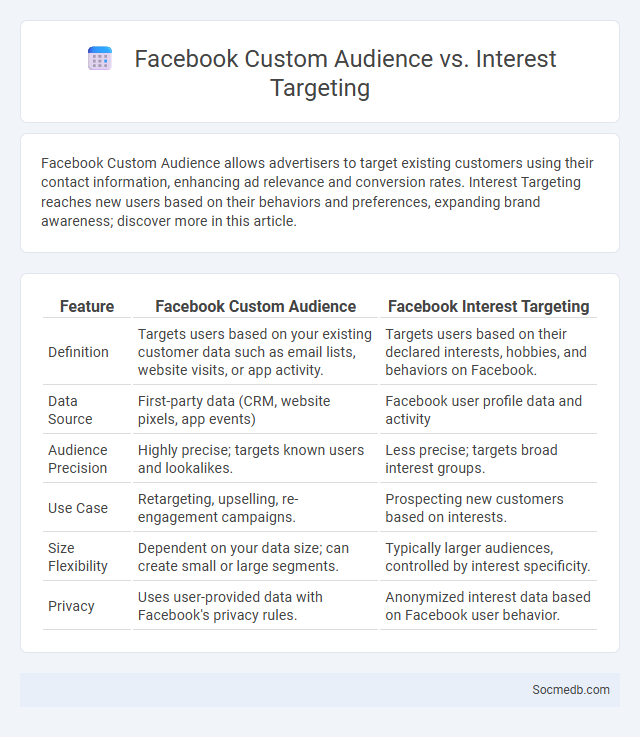
Photo illustration: Facebook Custom Audience vs Interest Targeting
Facebook Custom Audience allows advertisers to target existing customers using their contact information, enhancing ad relevance and conversion rates. Interest Targeting reaches new users based on their behaviors and preferences, expanding brand awareness; discover more in this article.
Table of Comparison
| Feature | Facebook Custom Audience | Facebook Interest Targeting |
|---|---|---|
| Definition | Targets users based on your existing customer data such as email lists, website visits, or app activity. | Targets users based on their declared interests, hobbies, and behaviors on Facebook. |
| Data Source | First-party data (CRM, website pixels, app events) | Facebook user profile data and activity |
| Audience Precision | Highly precise; targets known users and lookalikes. | Less precise; targets broad interest groups. |
| Use Case | Retargeting, upselling, re-engagement campaigns. | Prospecting new customers based on interests. |
| Size Flexibility | Dependent on your data size; can create small or large segments. | Typically larger audiences, controlled by interest specificity. |
| Privacy | Uses user-provided data with Facebook's privacy rules. | Anonymized interest data based on Facebook user behavior. |
Introduction to Facebook Targeting Options
Facebook targeting options enable advertisers to precisely reach audiences based on demographics, interests, behaviors, and location. Advanced tools like Custom Audiences allow marketers to engage previous customers, while Lookalike Audiences expand reach to users similar to existing clients. Utilizing detailed targeting increases ad relevance, improving engagement rates and maximizing return on ad spend.
What Is Facebook Custom Audience?
Facebook Custom Audience is a powerful advertising tool that allows you to target specific groups of people based on your existing customer data, such as email addresses, phone numbers, or website visitors. By matching this data with Facebook users, it enables highly personalized ad campaigns tailored to your audience's interests and behaviors. Using Custom Audiences, you can effectively re-engage past customers, increase conversions, and maximize your advertising ROI.
Understanding Facebook Interest Targeting
Facebook interest targeting enables advertisers to reach specific audiences by leveraging user behaviors, activities, and expressed interests on the platform. This targeting method uses data points such as liked pages, engaged content, and stated hobbies to create refined audience segments. Optimizing campaigns with Facebook interest targeting increases ad relevance, boosts engagement rates, and improves return on ad spend (ROAS).
Custom Audience vs. Interest Targeting: Key Differences
Custom Audience enables you to target users based on your existing customer data, such as email lists or website visitors, ensuring highly personalized marketing campaigns. Interest Targeting focuses on reaching users by their hobbies, behaviors, and preferences without needing prior customer information, expanding your brand's reach to potential new audiences. Understanding these key differences helps optimize your social media strategy for better engagement and conversion rates.
Data Sources for Custom Audiences
Custom Audiences on social media platforms rely heavily on diverse data sources such as email lists, website traffic via tracking pixels, and app activity to create targeted marketing segments. First-party data gathered through CRM systems and customer interactions enriches audience precision, while offline data like in-store purchases can be uploaded to align online campaigns. Combining behavioral data and user engagement metrics enables advertisers to tailor ads effectively and enhance campaign ROI.
How Interest Targeting Works
Interest targeting on social media platforms leverages user behavior, preferences, and interactions to deliver highly relevant ads, increasing engagement and conversion rates. By analyzing your online activity such as liked posts, followed pages, and shared content, algorithms categorize you into specific interest groups for precise ad placements. This targeted approach maximizes ad efficiency, connecting your brand with audiences most likely to engage based on their demonstrated interests.
Pros and Cons: Custom Audience
Custom Audience on social media enables precise targeting by allowing advertisers to upload existing customer data, improving campaign relevance and ROI through personalized ads. It helps increase engagement rates and conversion by reaching users already familiar with the brand. However, privacy concerns and data compliance issues pose risks, while inaccurate or outdated data can lead to inefficient ad spend and reduced campaign effectiveness.
Pros and Cons: Interest Targeting
Interest targeting in social media advertising enables precise audience segmentation based on user behaviors, preferences, and demographics, increasing the relevance and effectiveness of campaigns. This method can boost engagement rates and conversion by delivering tailored content to users showing interest in specific topics or products. However, it may also limit reach to a narrow audience, potentially excluding broader demographics and causing privacy concerns due to extensive data collection.
Which Targeting Option Delivers Better ROI?
Advanced audience targeting options such as lookalike audiences and behavior-based segmentation deliver better ROI by reaching users most likely to engage with your product or service. Leveraging data-driven platforms like Facebook Ads Manager and Google Ads allows you to optimize campaigns based on demographics, interests, and past purchase behavior, maximizing your ad spend efficiency. By focusing on precise targeting techniques, your marketing efforts convert higher and reduce wasted impressions, enhancing overall revenue generation.
Best Practices for Combining Custom Audience and Interest Targeting
Combining custom audience and interest targeting maximizes social media campaign precision by leveraging existing customer data alongside specific user behaviors and preferences. Utilizing lookalike audiences derived from custom data while layering interest-based filters enhances ad relevance and engagement rates. Continuous testing and data analysis ensure optimal audience overlap and exclude non-performing segments to improve conversion efficiency.
 socmedb.com
socmedb.com